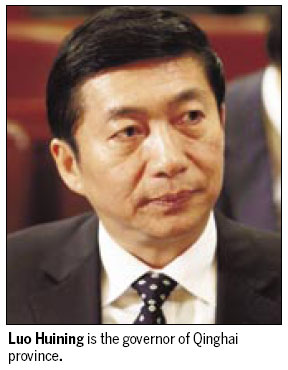

BEIJING - Luo Huining says Utah is a mirror and a textbook for Qinghai.
The governor of the northwestern Chinese province sees many similarities between Qinghai and the southwestern US state.
Both are highland places known for salt lakes. Both were once barren, sparsely populated regions but have been developing quickly in recent years.
And as China and the United States look to develop their green economies, Qinghai and Utah both hope to be standout players by banking on their rich natural resources, such as wind and solar power.
"The similar development pattern and the common interest between Qinghai and Utah create favorable opportunities and room for growth," Luo, 57, said a week before he traveled to the China-US Governors Forum held in Salt Lake City.

Qinghai and Utah have previously worked together in such fields as the creative industry, on highland clinics and in developing salt-sea chemicals.
Asked which industries he is going to promote to US investors, Luo listed new energy, the green economy and tourism as Qinghai's strengths and future. The province's natural resources are a boon to the new energy industry, Luo said.
He said Qinghai boasts the third-largest wind power resource in China with an estimated capacity of 12 gigawatts, compared with China's total installed capacity of 44.7 gW by the end of last year.
He said only 150 megawatts of Qinghai's wind power capacity has thus far been developed but that the province plans to install wind power facilities capable of producing 1.5 gW of power in the next five years with the aim of reaching 2.5 gW in 2020.
Qinghai's solar energy industry, Luo said, is also filled with a great deal of potential.
The province has installed a capacity of 50 mW of solar energy. The capacity will be increased to 200 mW in five years before reaching 2 gW in 2020. Luo said that these figures show the demand for alternative energies, new materials and efficient cars will grow quickly.
Qinghai is China's fourth-largest province at 720,000 square kilometers.
With a population of 5.63 million, Qinghai's GDP reached 135.1 billion yuan ($20.89 billion) last year, one of the poorest among China's provinces. Its GDP was 3 percent of South China's Guangdong province, the Chinese mainland's largest economy.
Qinghai's effort to boost its green sector came after news that China plans to boost its use of renewable energy and transform its export-led economy.
The country aims to grow renewable energy consumption to 15 percent of the total energy consumption by 2020, up from 9.6 percent last year.
With its priority on a green economy, Qinghai is trying to avoid the hardships that China's developed coastal areas have endured, said Zeng Haiying, an economics professor at Guiyang-based Guizhou University.
"Inland and remote provinces like Qinghai cannot rely on an affluent labor pool or robust trade, which propelled the growth of coastal China at the cost of the environment," said Zeng, who specializes in studying inland China.
"Inland provinces' advantages lie in natural resources that are good for industries such as new energy and environmental protection," Zeng said.
Qinghai is the source of the three waterways that spawned Chinese civilization: Yangtze, Yellow and Lancang rivers. The province provides more than 60 billion cubic meters of water, about one-tenth of the maximum runoff of the Mississippi River, to other provinces each year.
Qinghai is at the frontline of the global fight against climate change, Luo said.
"We welcome US enterprises and universities, which are rich in capital, experience and technical know-how, to join our environmental campaign," he said.
Tourism is another sector that Luo hopes will attract US investors.
The province - home to 2.5 million ethnic people, or 47 percent of its population - offers a mixture of unique ethnic and religious cultures.
Last year, Qinghai attracted more than 46,700 international tourists, an increase of 29.4 percent year-on-year.
Though an official figure on the number of US tourists was unavailable, Luo said: "With the improvement of our services, more and more foreign travelers, including those from the US, will tour Qinghai."
Li Aoxue and Zhong Nan contributed to this story.
China Daily







